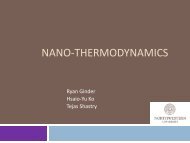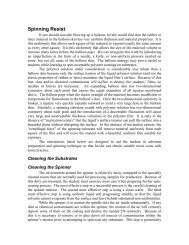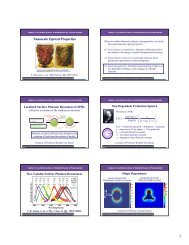A Practical Guide to SPM
A Practical Guide to SPM
A Practical Guide to SPM
Create successful ePaper yourself
Turn your PDF publications into a flip-book with our unique Google optimized e-Paper software.
In the linear region of the curves (region b), the slope is related <strong>to</strong> the<br />
cantilever stiffness when the sample is infinitely hard. Here, the slope<br />
of the curve reflects the spring constant of the cantilever. However,<br />
when the cantilever is stiffer than the sample surface, or nearly as stiff<br />
as the sample surface, then the slope of the curve may enable<br />
investigation of the elastic properties of the sample.<br />
19<br />
Force spectroscopy can also be done with an oscillating cantilever. In<br />
this case, we can plot the cantilever’s amplitude, or phase, or both,<br />
versus the ramped parameter, which typically is the scanner voltage<br />
(tip-sample separation).<br />
Force Volume<br />
Force volume imaging is a method for studying correlations between<br />
tip-sample forces and surface features by collecting a data set<br />
containing both <strong>to</strong>pographic data and force-distance curves. As the<br />
<strong>to</strong>pographic data is collected, an array of force-distance curves is also<br />
collected. This type of data is then called force volume.<br />
Each force curve is measured at a unique X,Y position in the scan<br />
area. Force curves from the array of X,Y points are combined in<strong>to</strong> a<br />
three-dimensional array, or volume, of force data. The value at a point<br />
(X,Y,Z) in the volume is the deflection (force) of the cantilever at that<br />
position in space (Figure 6-2).<br />
Figure 6-2. Force volume.<br />
The force volume data set can be seen as a stack of horizontal slices,<br />
each slice representing the array of force data at a given height (as a<br />
function of the Z piezo position). A single force volume image<br />
represents one of these slices, showing the X,Y distribution of the force<br />
data over the scan area at that height. Comparing the <strong>to</strong>pography<br />
image <strong>to</strong> force volume images at various heights can reveal<br />
information about the lateral distribution of different surface and/or<br />
material properties, including electrostatic, chemical, and magnetic<br />
properties.<br />
Similarly, force volume data can be collected with an oscillating<br />
cantilever, where the AFM image is typically acquired with<br />
TappingMode AFM and the force vs. distance curves plot cantilever<br />
amplitude, phase, or even deflection.<br />
Advanced Force Spectroscopy<br />
The principles of force spectroscopy can be applied <strong>to</strong> more<br />
advanced kinds of studies using more accurate low-noise AFM<br />
instruments (e.g., MultiMode ® PicoForce or NanoMan ® II systems<br />
from Veeco Instruments). For example, the relative strengths of the<br />
chemical bonds within a single molecule can be measured and<br />
compared. The AFM tip can be used <strong>to</strong> “grab” the end of a molecule,<br />
such as a single folded protein. As the cantilever is retracted, the
















